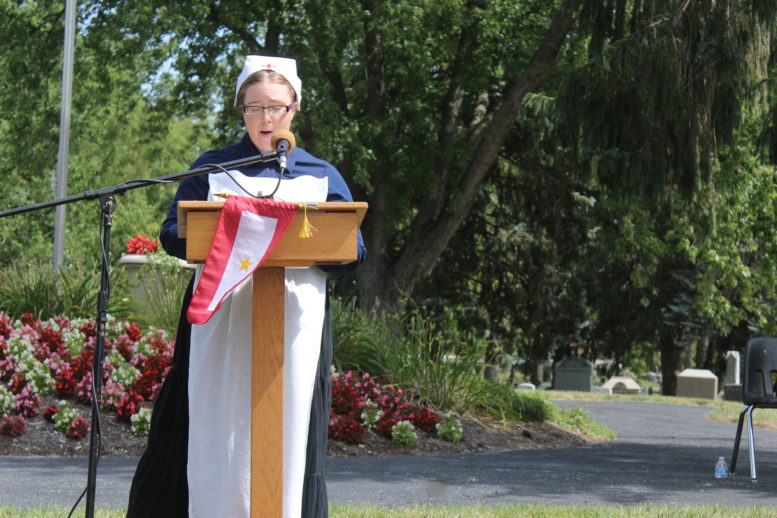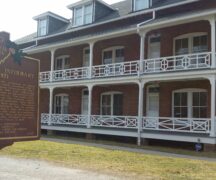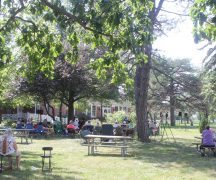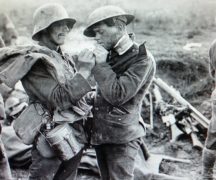By DAVID DUPONT
BG Independent News
World War I took its toll on Wood County.
Seventy-three young men, some still teenagers, died while in service in the war.
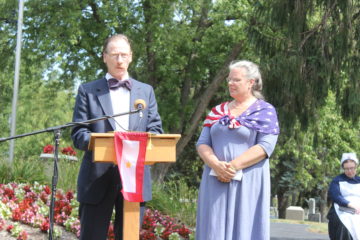
Peter Fry and Elizabeth Geer-Fry portray Jonathan and Addie Ladd.
All were remembered Sunday at the Living History Day at Oak Grove Cemetery. They were clerks, teachers, and many farmers and farmhands. When the United States entered the war in 1917, they answered the call by local recruiters to enlist, and they headed to France.
But the majority of those who died in uniform in the war never made it to France. Disease, especially pneumonia and influenza, were as much an enemy as Germany.
Those attending the annual event heard from them, or their bereaved parents. Those not given full presentations had their lives and deaths encapsulated in a few sentences and read solemnly by a troupe of high school students, not much younger than the dead soldiers.
That so many of the family names were familiar, only brought the tragedy of the war closer to home.
The first to go over there was a woman, Margaret Lehmann. She joined a contingent of Red Cross nurses at the beginning of the war in Europe in 1914. She was portrayed by Cassie Greenlee, with a script by Hal Brown.
First, Lehmann was stationed in France. There they saw how trench warfare, living in constant wet conditions, claimed the lower extremities. Infection set in quickly.
“Our nurses do what we can to help them,” the nurse said.
When her six months were over, and Lehmann could have returned home, she realized that “I knew somehow there was more I could do.”
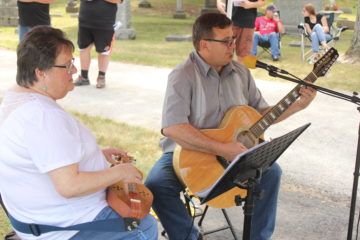
Joful Noise, Cleve and Irene Patten, performed before the ceremony.
She was then moved to Serbia to a hospital with capacity for 554, but with about 900 patients. These were the wounded from both sides of the conflict – Germans as well as French, Serbians, Gypsies Russians and more. Disease swept through the hospital. ”It’s easy to lose heart and lose hope,” she said. Still “we had an impact. We made a difference.”
When Lehmann returned to Bowling Green, she continued her work organizing and raising funds.
Vernon Wymer, who was portrayed by his great-great-great nephew Hunter Wymer with a script by Keith Guion, was the first soldier from Wood County to die in combat in the war.
He was the oldest son of his family, and had suffered his share of heartbreak with the death of his grandfather, a Civil War veteran, and his mother.
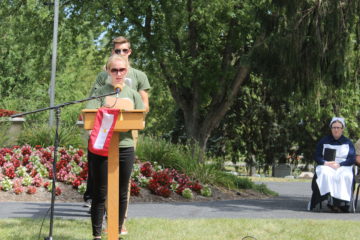
Elaine Hudson reads name of soldier from honor roll.Hudson Pendleton stands behind waiting his turn.
In 1914, he said, “the war as far away.” His family was more concerned with problems on the farm. But when the United States entered, and the local infantry company was trying to fill out its numbers, the 17-year-old enlisted.
After waiting for more enlistments and then being shifted to another unit, he shipped out for France in 1918, and died later that year in Marne, France.
His remains were returned to Ohio. When they arrived at the train station in North Baltimore, hundreds were on hand to meet them, and 4,000 people attended his funeral.
His family’s service continued beyond the war. A younger brother died in France, 30 miles from where Vernon died, during World War II, and they are buried side by side.
Milo Lybarger didn’t get to bury his son, Charles Clinton Lybarger. Milo Lybarger was given voice by Tom Pendleton, who wrote and performed the script.
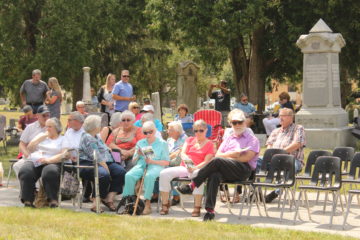
Audience at Oak Grove Cemetery
Charles Lybarger enlisted as well at the beginning of the war, and shipped off to France on the USS Ticonderoga. The ship, his father noted, had been taken by the Allies and repurposed as a troop carrier. The Ticonderoga, with 237 aboard, headed to Europe as part of a convoy, but when it developed engine problems was left behind. It was attacked by a U-Boat, and the crew defended the ship, before a torpedo sent it to the bottom.
Only 24 of those on the ship survived.
Lybarger was one of two from Wood County who died on the ship.
Ray Dudley Avery was an attorney who turned his skills as an organizer to use in the National Guard. His story was written and told by his granddaughter Terry Witt. Elected captain, he first was sent to the Mexican border where the United States was fending off incursions by the Mexican revolutionary Pancho Villa. He then went to France when the U.S. joined the hostilities there. He was sent home after contracting dysentery.
He continued to be active back in Bowling Green.
The presentations ended with the story of Jonathan and Addie Ladd, portrayed by Peter Fry and Elizabeth Geer-Fry, with script written by Millie Broka. Five of their 10 children served in the War, and their son Paul died in action, and was buried in Meuse-Argonne Cemetery in France.
In 1930, she joined a tour of other Gold Star mothers who traveled to France to visit the graves of their son. She said she was filed with awe to be able to see where her son was buried.
The local chapter of the Veterans of Foreign War was named for Ladd.
The event was ended with the playing of taps by Elizabeth Bostdorff with Keith Guion leading the singing of the words.
The high school students of read the roll call of those who died were: Charlotte Perez, Cole Nemeth, Elaine Hudson, Ethan Brown, Thomas Long, Ann Weaver, and Hudson Pendleton. Wood County Library Director Michael Penrod served as master of ceremonies.

